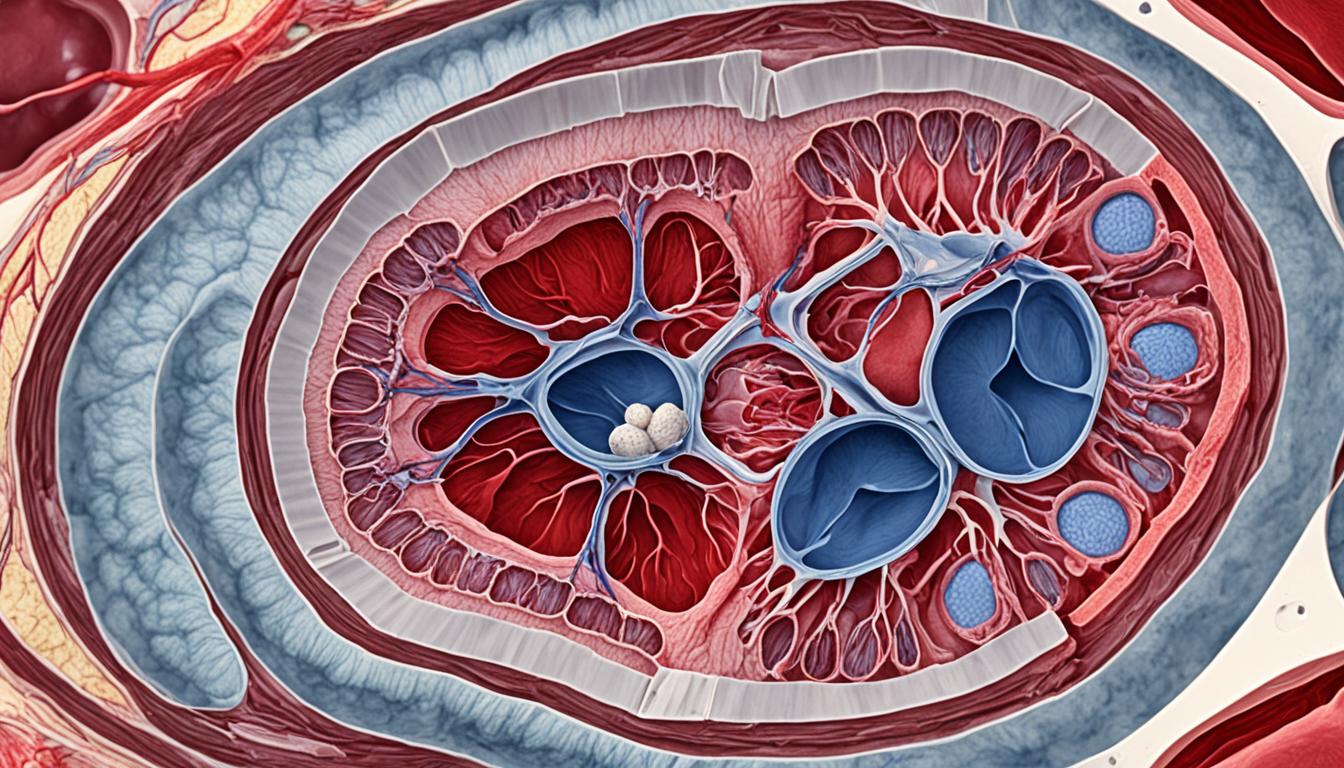Canine heart valve dysplasia is a developmental malformation of the mitral or tricuspid valve in the dog’s heart. This condition can lead to regurgitation of blood into the atria, resulting in various symptoms and complications. Certain dog breeds are more susceptible to heart valve dysplasia, and diagnosis is typically made through radiographs and echocardiography. While treatment focuses on managing congestive heart failure symptoms, the prognosis for dogs with heart valve dysplasia is generally guarded to poor.
Key Takeaways:
- Canine heart valve dysplasia refers to a developmental malformation of the mitral or tricuspid valve in dogs.
- Diagnosis is typically made through radiographs and echocardiography.
- Treatment focuses on managing congestive heart failure symptoms.
- Certain dog breeds, such as Bull Terriers, Newfoundlands, and Golden Retrievers, are more susceptible to heart valve dysplasia.
- The prognosis for dogs with heart valve dysplasia is generally guarded to poor.
Anatomy of the Canine Heart
The canine heart is a complex organ responsible for pumping blood throughout the body. Understanding the anatomy of the heart is crucial in comprehending heart valve dysplasia and its impact on a dog’s health.
The canine heart consists of four chambers – two atria and two ventricles. The atria are the top chambers, while the ventricles are the bottom chambers. These chambers are separated by atrioventricular valves, which ensure that blood flows in the correct direction during each heartbeat.
“The atrioventricular valves play a crucial role in preventing the backflow of blood during heart contractions.”
On the right side of the heart, we have the tricuspid valve. It is named so because it is composed of three leaflets or cusps. The tricuspid valve separates the right atrium from the right ventricle.
On the left side of the heart, we find the mitral valve. It consists of two cusps and separates the left atrium from the left ventricle. The mitral valve is also known as the bicuspid valve.
Atria and Ventricles
The atria receive blood from various parts of the body and lungs and then pump it into the ventricles. The ventricles, in turn, forcefully contract, propelling blood out of the heart to supply oxygen and nutrients to the body’s organs and tissues.
Atrioventricular Valves
The atrioventricular valves, including the tricuspid and mitral valves, ensure one-way blood flow by opening to allow blood to pass from the atria to the ventricles and closing to prevent backflow during ventricular contraction. They serve as vital barriers, ensuring the efficiency of the heart’s pumping action.
The tricuspid valve on the right side and the mitral valve on the left side both enable the heart to function properly by directing blood flow through the proper chambers and preventing regurgitation.
| Atrioventricular Valve | Location | Leaflets or Cusps |
|---|---|---|
| Tricuspid Valve | Right side of the heart | Three |
| Mitral Valve | Left side of the heart | Two |
Blood flow through the heart is a coordinated process regulated by the chambers and valves, ensuring efficient circulation and oxygenation of the dog’s body. Any abnormalities in the structure or function of these valves, such as heart valve dysplasia, can disrupt this delicate balance and lead to significant health issues for our beloved canine companions.
Breeds Predisposed to AV Valve Dysplasia
Certain dog breeds are more likely to be born with abnormal atrioventricular (AV) valves. This congenital condition can affect both the mitral valve and the tricuspid valve, leading to mitral valve dysplasia and tricuspid valve dysplasia, respectively.
Mitral Valve Dysplasia
Breeds that have a higher risk of developing mitral valve dysplasia include:
- Bull Terriers
- Newfoundlands
- Great Danes
- Golden Retrievers
- Mastiffs
- Rottweilers
- Dalmatians
Tricuspid Valve Dysplasia
On the other hand, the following breeds are more susceptible to tricuspid valve dysplasia:
- Labrador Retrievers
- German Shepherd Dogs
- Weimaraners
- Irish Setters
- Dogue de Bordeaux
- Great Pyrenees
- Old English Sheepdogs
These breeds have a predisposition to AV valve dysplasia, but it’s important to remember that the condition can still occur in other breeds as well. Regular veterinary check-ups and screening are crucial, especially for breeds known to be susceptible to heart valve dysplasia.
Early detection and prompt treatment can help manage the condition and improve the overall quality of life for affected dogs.
Symptoms of AV Valve Dysplasia
The signs of AV valve dysplasia can vary but typically manifest within the first few years of life. Dogs may experience exercise intolerance, weight loss, abdominal fluid accumulation, and stunted growth. Symptoms specific to mitral valve dysplasia include heart murmurs, rapid breathing, coughing, and bluish discoloration of mucous membranes. Tricuspid valve dysplasia may present with similar signs along with enlarged jugular veins and fluid accumulation in the abdomen or legs.
AV valve dysplasia can significantly affect a dog’s overall well-being. Exercise intolerance is a common symptom, with affected dogs unable to engage in physical activities for extended periods without experiencing fatigue or respiratory distress. Weight loss is often observed due to the body’s impaired ability to extract nutrients from food properly.
The accumulation of fluid in the abdomen, known as ascites, occurs as a result of the backflow of blood caused by the faulty AV valves. This fluid accumulation can lead to a distended abdomen and discomfort for the dog. Additionally, stunted growth may be evident in puppies with AV valve dysplasia, as the heart’s inefficiency affects the body’s overall growth and development.
“Heart murmurs, one of the most common signs in dogs with mitral valve dysplasia, can be detected during a routine veterinary examination. These abnormal sounds occur due to the turbulent blood flow caused by the regurgitation of blood through the faulty valve.”
Other symptoms specific to mitral valve dysplasia include rapid breathing or panting, coughing, and bluish discoloration of the mucous membranes, such as the gums and tongue. These signs indicate poor oxygenation and circulation, resulting from the heart’s inability to efficiently pump blood.
Tricuspid valve dysplasia shares similar symptoms with mitral valve dysplasia, with the addition of enlarged jugular veins and fluid accumulation in the abdomen or legs. Enlarged jugular veins result from the backflow of blood and increased pressure within the venous system. Fluid accumulation, known as edema, can cause swelling in the abdomen (ascites) or limbs, leading to discomfort and impaired mobility.
Symptoms of AV Valve Dysplasia
| Signs of AV Valve Dysplasia | Specific Signs of Mitral Valve Dysplasia | Specific Signs of Tricuspid Valve Dysplasia |
|---|---|---|
| Exercise intolerance | Heart murmurs | Enlarged jugular veins |
| Weight loss | Rapid breathing | Fluid accumulation (edema) |
| Abdominal fluid accumulation (ascites) | Coughing | |
| Stunted growth | Bluish discoloration of mucous membranes |
Recognizing the symptoms of AV valve dysplasia is crucial for early detection and timely veterinary intervention. If you notice any of these signs in your dog, it is recommended to consult with a veterinarian experienced in cardiac conditions to determine the underlying cause and appropriate management strategies.
Diagnosis of AV Valve Dysplasia
Accurate diagnosis plays a vital role in managing AV valve dysplasia in dogs. Veterinary professionals employ various diagnostic procedures to assess the condition and determine the best course of treatment. Radiographs and echocardiography are two primary tools used for diagnosing and monitoring AV valve dysplasia.
Radiographs: Assessing for Abnormalities
Radiographs, also known as X-rays, are a common diagnostic procedure used to evaluate the dog’s chest and detect any abnormalities in the heart and surrounding structures. Through radiographs, veterinarians can assess the size and shape of the heart, identify abnormalities in the valves or chambers, and evaluate the overall condition of the cardiovascular system.
While radiographs provide valuable initial insights, they are not definitive for diagnosing AV valve dysplasia. Further diagnostic tests, such as echocardiography, are necessary to confirm the condition and assess its severity.
Echocardiography: A Definitive Diagnostic Tool
Echocardiography is the gold standard diagnostic procedure for AV valve dysplasia. This non-invasive imaging technique utilizes sound waves to create detailed images of the heart’s structure and function. By examining the heart chambers, valves, and blood flow, veterinarians can accurately diagnose AV valve dysplasia, determine the extent of the deformities, and assess the severity of valve regurgitation.
Echocardiography also enables veterinarians to monitor the progression of heart failure in dogs with AV valve dysplasia. Regular echocardiograms allow for ongoing assessment and adjustment of treatment plans to optimize the dog’s quality of life.
| Diagnostic Procedures | Advantages | Limitations |
|---|---|---|
| Radiographs |
|
|
| Echocardiography |
|
|
Accurate diagnosis through radiographs and echocardiography enables veterinarians to formulate an appropriate treatment plan for dogs with AV valve dysplasia. With a definitive diagnosis, veterinary professionals can provide targeted care and support to improve the dog’s quality of life.
Treatment of AV Valve Dysplasia
The primary goal in managing AV valve dysplasia is to effectively address the signs of congestive heart failure. This is typically accomplished through a combination of medication, restricted activity, and nutritional changes.
Medication
Medication plays a crucial role in the treatment of AV valve dysplasia. Commonly prescribed drugs include diuretics, ACE inhibitors, and Vetmedin. Diuretics help to reduce fluid retention and decrease the workload on the heart, while ACE inhibitors relax blood vessels, reducing blood pressure and workload on the heart. Vetmedin, on the other hand, is a medication specifically designed to improve heart function and decrease symptoms of congestive heart failure.
Restricted Activity
Restricted activity is necessary to ensure that the dog’s exercise tolerance is not exceeded, as excessive physical exertion can put additional strain on the already compromised heart. It is important to work closely with a veterinarian to determine the appropriate level of activity restriction and monitor the dog’s response to exercise.
Nutritional Changes
Nutritional changes may also be recommended as part of the treatment plan for AV valve dysplasia. Sodium restriction is often advised to help reduce fluid retention and manage the symptoms of congestive heart failure. A balanced diet that meets the nutritional needs of the dog while supporting heart health is crucial.
Prognosis and Breeding
Unfortunately, the prognosis for dogs with AV valve dysplasia is generally guarded to poor. The condition is typically progressive, and long-term management is required to maintain the dog’s quality of life. It is important to note that affected dogs should not be used for breeding, as AV valve dysplasia can be an inherited condition.
Sources:
- Hurley, K. A., & Stern, J. A. (2015). Canine degenerative myxomatous mitral valve disease: natural history, clinical presentation and therapy. Journal of Veterinary Cardiology, 17 Suppl 1, S126-S139.
- Bonagura, J. D., & Stepien, R. L. (2009). Canine degenerative mitral valve disease: from physiopathology to treatment. Veterinary Clinics of North America: Small Animal Practice, 39(6), 1069–1087.
| Treatment Methods | Key Benefits |
|---|---|
| Medication | – Reduces fluid retention – Decreases workload on the heart – Improves heart function |
| Restricted Activity | – Prevents excessive strain on the heart – Manages exercise tolerance |
| Nutritional Changes | – Sodium restriction reduces fluid retention – Supports heart health |
Mitral Valve Dysplasia in Cats
Mitral valve dysplasia is a common congenital heart defect in cats. It is characterized by the abnormal formation of the mitral valve, resulting in mitral regurgitation. Cats with this condition may experience exercise intolerance, labored breathing, coughing, and fainting. Diagnosis is typically made through echocardiography, and treatment focuses on managing congestive heart failure symptoms if present.
Mitral valve dysplasia is a significant feline heart condition, known for being a common congenital defect. The condition arises from an irregular development of the mitral valve which leads to mitral regurgitation, a backward flow of blood into the left atrium of the heart. Cats affected by mitral valve dysplasia often present with noticeable symptoms such as exercise intolerance, labored breathing, coughing, and even fainting.
To diagnose mitral valve dysplasia in cats, veterinarians rely on specialized imaging techniques like echocardiography. This non-invasive procedure provides detailed images of the heart structure, allowing for an accurate diagnosis. Furthermore, echocardiography aids in assessing the severity of the condition and helps guide treatment decisions.
Treatment for mitral valve dysplasia in cats primarily focuses on managing congestive heart failure symptoms, which may include medication to control fluid buildup, improve heart function, and alleviate discomfort. Medication, dietary modifications, and careful monitoring under veterinary guidance can help improve the cat’s overall and heart health.
Living with Mitral Valve Dysplasia
Cats with mitral valve dysplasia can lead fulfilling lives with proper care and management. It’s crucial to provide a low-stress environment, especially by minimizing physical exertion and avoiding excessive activities that may strain the heart. Regular veterinary check-ups and echocardiograms are recommended to monitor the cat’s heart health and adjust treatment as necessary.
Medication compliance is essential in the long-term management of mitral valve dysplasia. Administering prescribed medications, such as diuretics and ACE inhibitors, as directed by the veterinarian, can help control symptoms and prevent the progression of heart failure.
“Mitral valve dysplasia poses significant challenges, but with consistent medical care and lifestyle adjustments, cats affected by this condition can enjoy a good quality of life.”
It’s important to remember that mitral valve dysplasia in cats carries a guarded prognosis. The condition is not curable, and managing heart failure symptoms is the primary goal of treatment. However, with early detection, diligent care, and regular follow-ups, cats with mitral valve dysplasia can live comfortably for an extended period.
| Treatment | Description |
|---|---|
| Medication | Prescribed drugs to manage symptoms and improve heart function, including diuretics and ACE inhibitors. |
| Dietary modifications | Special diets low in sodium to help alleviate fluid retention and reduce strain on the heart. |
| Regular veterinary check-ups | Monitoring the cat’s heart health through echocardiograms and adjusting treatment plans as needed. |
| Low-stress environment | Minimizing physical exertion and providing a calm and peaceful living space for the cat. |
Complications and Prognosis
Heart valve dysplasia can lead to the enlargement of the heart chambers over time, posing significant complications for affected animals. One common complication is the development of left-sided congestive heart failure, which is characterized by the accumulation of fluid in the lungs, a condition known as pulmonary edema. In left-sided congestive heart failure, the enlargement of heart chambers impairs the heart’s ability to efficiently pump blood, causing fluid to back up into the lungs, leading to respiratory distress and reduced oxygenation.
In addition to left-sided congestive heart failure, animals with heart valve dysplasia may also be at a higher risk for developing atrial fibrillation. Atrial fibrillation is an irregular heart rhythm that occurs when the upper chambers of the heart, called the atria, quiver instead of contracting properly. This can disrupt the heart’s normal electrical signals and further compromise its function. Atrial fibrillation can have a negative impact on the overall prognosis and outcome for animals with heart valve dysplasia.
The prognosis for animals with heart valve dysplasia is generally guarded, and the average survival time varies depending on the severity of the condition. While medical therapy, including the use of diuretics, ACE inhibitors, and Vetmedin, may be prescribed to manage congestive heart failure symptoms, the overall prognosis remains limited. On average, animals with heart valve dysplasia have a survival time of 1-2 years.
Likelihood of Complications
The enlargement of heart chambers resulting from heart valve dysplasia can significantly impact an animal’s quality of life and prognosis. The degree of enlargement and subsequent complications depend on various factors, including the severity of the valve malformation, the underlying breed predisposition, and the timely initiation of appropriate medical management. Animals with severe valve dysplasia are more likely to experience rapid progression of enlargement and congestive heart failure, leading to a shorter survival time.
Prognosis and Life Expectancy
The prognosis for animals with heart valve dysplasia is influenced by several factors, including the presence of complications, the response to medical therapy, and the overall health of the individual animal. While medical management can help alleviate symptoms and improve the overall quality of life, it cannot cure the underlying condition. Therefore, it is essential for pet owners to work closely with their veterinarians to develop a comprehensive management plan that includes regular follow-up appointments, medication compliance, and lifestyle modifications.
Although heart valve dysplasia can significantly impact an animal’s prognosis, each case is unique, and some animals may respond better to treatment and have a longer life expectancy. The average survival time of 1-2 years should serve as a general guideline, but individual outcomes may vary. With attentive veterinary care and a commitment to providing a low-stress environment, animals with heart valve dysplasia can enjoy a fulfilling life for as long as possible.
| Complications of Heart Valve Dysplasia | Prognosis | Average Survival Time |
|---|---|---|
| Enlargement of heart chambers | Guarded | 1-2 years |
| Left-sided congestive heart failure | – | – |
| Atrial fibrillation | – | – |
Surgical Options
In rare cases, surgical repair can be attempted in dogs with heart valve dysplasia. This option is considered when the affected valve’s condition and the overall health of the dog are favorable. However, it’s important to note that not all dogs are suitable candidates for surgery, and the decision to proceed with surgical intervention is made on a case-by-case basis.
The success of surgical repair in managing heart valve dysplasia can vary. Factors such as the severity of the dysplasia, the overall health of the dog, and the expertise of the veterinary surgeon play significant roles in determining the outcome. It is crucial to consult with a veterinary specialist experienced in cardiac surgery to assess the potential benefits and risks associated with surgery.
During the surgical repair procedure, the veterinary surgeon aims to correct the structural abnormalities and restore the proper functioning of the affected valve. This may involve techniques such as valve repair or replacement, depending on the specific case.
It is important to understand that surgical repair is not a guaranteed solution for heart valve dysplasia, and the outcomes can be variable. Some dogs may experience significant improvement in their cardiac function and quality of life, while others may have more limited improvement or face additional challenges post-surgery.
Close collaboration between the pet owner, referring veterinarian, and the veterinary surgeon is essential to determine the best course of action and manage expectations regarding the surgical repair of heart valve dysplasia.
Lifelong Management and Care
Dogs and cats with heart valve dysplasia require long-term care to ensure their well-being and maintain their quality of life. It’s essential to establish a comprehensive healthcare plan that includes regular check-ups, optimal medication compliance, and lifestyle modifications.
Regular check-ups with a veterinarian specializing in cardiology are crucial for monitoring the progression of the condition and making informed treatment decisions. Echocardiograms, a non-invasive imaging technique, provide detailed insights into the structure and function of the heart. These diagnostic procedures help assess the effectiveness of the current treatment and guide adjustments as needed.
Medication compliance is a key aspect of managing heart valve dysplasia. Following the prescribed medication regimen precisely can significantly improve the animal’s heart health and overall well-being. Adjustments to the medication may be necessary based on the pet’s response and overall health status. It’s important to communicate openly with the veterinarian and report any changes or concerns promptly.
Aside from medical care, providing a low-stress lifestyle is beneficial for pets with heart valve dysplasia. Minimizing exposure to stressful situations and creating a calm environment can help reduce the risk of exacerbating heart-related symptoms. Additionally, a balanced diet tailored to the specific needs of the animal can support their overall health and potentially improve heart function.
| Key Points for Lifelong Management and Care |
|---|
| Regular veterinary check-ups, including echocardiograms, are essential |
| Medication compliance is crucial for optimizing treatment outcomes |
| A low-stress lifestyle contributes to the well-being of pets with heart valve dysplasia |
| A balanced diet tailored to their needs can support overall health |
Conclusion
Heart valve dysplasia is a significant cardiac condition in dogs and cats, with specific breed predispositions. Early detection, accurate diagnosis, and proper management are essential in maintaining the overall heart health of pets with this condition. While the prognosis is guarded, ongoing veterinary care, medication, and lifestyle modifications can help improve the quality of life for these animals. Veterinary cardiology plays a vital role in diagnosing and treating heart issues in dogs and cats, ensuring their cardiac well-being.
Managing heart issues in dogs and cats requires a multidisciplinary approach, involving veterinarians, pet owners, and caregivers. Regular check-ups, diagnostic procedures, and compliance with prescribed medications are crucial for long-term care. Providing a low-stress lifestyle, balanced nutrition, and exercise appropriate for the pet’s condition can further support heart health in pets. It is important to remain vigilant, recognizing and addressing any changes in behavior, exercise tolerance, or respiratory function that may indicate worsening cardiac disease.
By prioritizing heart health in pets and working closely with veterinary professionals, pet owners can make a significant impact on their animal’s well-being. While heart valve dysplasia may present challenges, the dedication to managing cardiac diseases in dogs and cats can greatly enhance the lives of these beloved companions. From early intervention to ongoing care, every effort contributes to improving the prognosis and ensuring a better quality of life for pets with heart issues.







